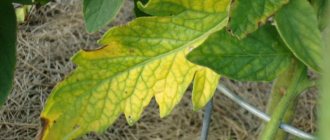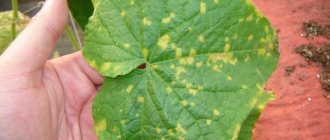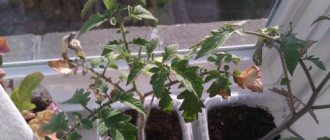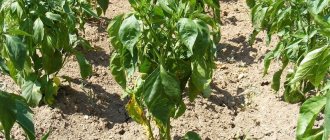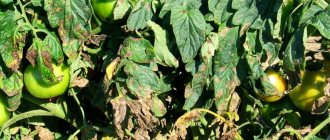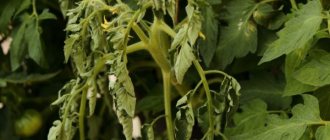Tomatoes: what kind of culture?
The homeland of tomatoes is South America. This is an annual heat-loving plant of the Solanaceae family. Characteristics:
- stem - erect, slightly pubescent;
- flowers - yellow;
- ovaries - elongated, spherical;
- The fruits are round and juicy.
Tomatoes are fastidious plants. They need plenty of warmth and light. The optimal temperature for seed germination is +25-27 degrees, so in Russian conditions it is better to plant seedlings in greenhouses in early spring, because the growing season and development are quite long.
It is equally important to provide greenhouse tomato seedlings with adequate lighting. But the plants are undemanding when it comes to moisture, but you need to water them in moderation, otherwise the fruits will dry out and crack, and the ovaries will fall off. The seedlings will become frail, weak, and unstable to fungal diseases.
Tomatoes
Note! The leaves begin to turn yellow immediately when the root system is damaged or the seedlings outgrow. If you initially plant early, then when planted in open ground the root system will be thinned and tangled into a lump.
Why do tomatoes turn yellow in a greenhouse?
Why do tomato leaves turn yellow?
There can be many reasons for the yellowness of tomato leaves:
- Damage and improper functioning of the root system when planting seedlings in small containers, when the roots begin to intertwine with each other (forming a dense lump) and stop development.
- Lack of moisture, causing yellowing and falling leaves. For tomatoes, abundant but infrequent watering at the root is preferable.
- Lack of nitrogen causes the leaves to turn yellow and whitish. This negatively affects the vegetative mass of seedlings, leads to slower growth of green mass, and pale foliage color.
- Failure to comply with the light regime, which happens when seedlings are densely planted, and grown plants in pots become cramped and dark.
- Hypothermia, when an unexpected cold snap can lead to freezing of the bushes and the appearance of yellowness on the leaves.
- Fungal infection. Leaves wither due to fusarium or artnactosis, the reason for which is untimely treatment of seeds before planting in the greenhouse, contaminated soil, and penetration of the fungus into the tissues of the bush during the growth period.
One of the reasons why the leaves of tomatoes in a greenhouse turn yellow is failure to comply with the timing of transplanting seedlings. Also, old leaves begin to lighten, because the required amount of nutritional components no longer reaches them. The root system dies off and clumps up due to lack of space in the containers.
Fusarium
Mistakes in caring for seedlings and how to correct them
Drying out the earthen coma may also be the answer to the question of why the leaves turned yellow. It is necessary to remove damaged parts, restore watering and treat the plants with a fungicide. Excess humidity in the greenhouse and overwatering can also cause this problem. For tomatoes, a little overdrying is better than flooding. The greenhouse needs to be ventilated.
Another reason may be early planting of tomatoes in the ground. Sudden temperature changes have a negative impact on plants: they lag behind in growth and development, and the leaves turn yellow with a hint of blue. There is no need to fertilize at low temperatures - this causes a similar effect.
When the leaf blade turns yellow, but the veins remain green, this is a sign of chlorosis or lack of nutrients in the soil. It is necessary to determine which microelement the seedlings need and add it to the soil.
Reasons for yellowing of leaves when transplanted into a greenhouse
Cucumbers turn yellow in a greenhouse: what to do
It happens that the leaves (upper, lower) begin to turn yellow and wither after transplanting the seedlings into the greenhouse. It is important to identify the reasons why tomatoes begin to turn yellow immediately after transplanting into the greenhouse and help eliminate problems at an early stage. Severely weakened tomatoes will take a long time to get sick and take root. The fruiting period can be quite prolonged.
If tomato seedlings turn yellow at the level of the lower leaves after planting in a greenhouse, then the probable reasons are as follows:
- Soil acidification, when the absorption process is disrupted and plants begin to receive less minerals. For example, a lack of nitrogen in the soil leads to yellowness, fragility, and thinning of leaf blades (stems); a deficiency of potassium (molybdenum, magnesium, steel) leads to drying out of the edges of the leaves leaving a green vein in the center, covering the leaf blades with mosaic spots in places where yellowness appears. .
- No watering. The foliage begins to turn yellow due to the lack of functioning of the root system, the movement of phosphorus and nitrogen from the leaves to the stem.
- A lack of microelements causes yellowing of the leaves of the lower tiers of tomatoes, since the upper young leaves begin to absorb most of the nutritional components.
Lack of moisture is a common cause of yellowing.
Note! If the seedlings were planted too densely, then after transplanting into the greenhouse the leaves may remain yellow for a long time. Tomatoes will take a long time to get sick and recover.
The upper leaves of tomatoes begin to turn yellow due to a lack of beneficial microelements in the soil. Deficit:
- boron leads to yellowing of the apical leaves, dying off of the bushes, decreased growth, pollination and fertilization;
- calcium causes blossom end rot, damage to upper flowers, yellowing of young leaves with the appearance of characteristic opalines;
- sulfur lightens the upper leaves, causes the appearance of reddish veins, thinness and fragility of the stems;
- iron leads to yellowness of young leaves and plates in the center, leaving a green border around the edges;
- manganese, when there is an uneven color in the veins, yellowing of the foliage at the top of the plants, gradual drying out and complete damage to the leaves of the lower row.
Additional Information! Tomato leaves often turn yellow due to improper watering. Water should not be allowed to get on the green mass, so it is necessary to water only at the root.
Common mistakes
Now a few words about common mistakes made by summer residents:
- No preventive measures are being taken. Most often, gardeners themselves become the cause of yellowing of tomato leaves. Planting too close, improper watering, improper fertilizing - all these are manifestations of improper crop care.
- Everything is done the other way around. For some reason, it is most often believed that in case of any problem, plants need to be watered and fed. Although very often the exact opposite happens: you need to exclude fertilizing and watering for at least a few days.
- Ignoring the problem. It also happens that yellowing is completely ignored. As a result, the disease spreads and the bush dies. Although at the very beginning it was still possible to save him.
How to treat seedlings
Why do pear leaves turn yellow in May?
If you do not take urgent and adequate measures to correct the current situation, the tomatoes may die. First of all, you should try to adapt the sluggish yellowed seedlings, for which:
- spray with phosphate fertilizer (weak solution);
- feed constantly until new leaves grow and the plant is completely restored, saturated with nutrients (nitrate, chloride, phosphate);
- treat the root system with a store-bought stimulant to form new roots.
Note! Experts advise feeding tomatoes with complex fertilizers. Using traditional methods, you can prepare a stock solution of chicken droppings and water the beds. If a stimulant is used, then treatments must be carried out strictly according to the instructions.
Phosphate fertilizer
Basic methods for eliminating errors if tomatoes turn yellow after planting in a greenhouse:
- If the lower leaves of a row and the stem of seedlings turn yellow due to damage to the root system or careless loosening of the soil, then use Kornevin for watering. To reanimate the roots, you can spray the tomato bushes with complex fertilizer.
- Drying and yellowing of leaves due to overheating of seedlings or sudden temperature changes (which often happens during the day and at night in greenhouses, when the leaves begin to turn yellow and dry, lose their elasticity, and the root system weakens) - it is necessary to stabilize the temperature in the greenhouse, place a barrel next to the seedlings with water. So the water will heat up during the daytime and absorb heat, and release it back at night.
- High acidity and heavy soil harm seedlings. When yellowness appears, you should pay attention to the soil. Before planting tomatoes in the greenhouse, prepare a mixture of peat, garden soil, sifted river sand and ash. Till the soil, dig up. If it is noticed that the soil begins to sour and the water begins to stagnate, then the situation can be prevented if after each watering you loosen the soil, thus normalizing the acidity level.
- If the leaves turn yellow due to a lack of nitrogen, it is worth fermenting the soil with fermented mullein. Prepare a solution: water (20 l.), mullein (1 l.) or spray the bushes with a solution of potassium permanganate containing warm water (10 l.), manganese (1 tbsp.).
Tomato leaves acquire a marbled color due to a lack of iron in the soil. You can make up for the deficiency by adding manure solution and ash (1*10). Experts also recommend taking forest soil, for example, collected near a maple tree, for planting tomatoes in polycarbonate greenhouses. It is this kind of soil that will become balanced and nutritious for tomatoes.
Nutritional deficiencies
The appearance of yellow leaves on tomatoes in a greenhouse may be a signal that the plant is not being fertilized correctly.
The wrong fertilizers may be applied or in the wrong amounts. At all stages of development, garden crops need potassium, nitrogen, magnesium and other macro- and microelements. Their deficiency, as well as their excess, negatively affects not only the greenness of tomatoes, but also the plant as a whole.
If the sprouts of the crop are weak, with thin stems and small leaves, the tomatoes do not receive enough nitrogen. In this case, the plant is watered using nitrogen-containing fertilizers. The simplest solution is to water the tomatoes:
- urea solution;
- infusion of manure.
A lack of potassium is indicated by the appearance of small yellow dots, which subsequently merge into a single yellow spot.
To replenish potassium reserves in tomato beds, you need to water them with a solution of potassium sulfate.
With a lack of manganese, young leaves begin to turn yellow first, and only then old ones. Insufficient phosphorus reserves lead not only to the appearance of yellow leaves, but also to their subsequent death. The plant reacts to a lack of magnesium by curling yellowed leaves.
How to fix the situation
The solution to the problem is proper feeding of tomato beds. The best option would be to apply a complex fertilizer offered in specialized stores. They contain all the nutrients necessary for vegetable crops.
Diseases and pests
Often the tender, juicy roots of tomatoes are attacked by harmful insects:
- the mole cricket, which prefers to feed on organic matter and build nests, causing yellowing of the leaves;
- The wireworm begins to lay larvae on the roots of the tomatoes or nearby, eat the succulent roots, making their way to the stems, as a result of which the leaves begin to lighten, and the bushes may eventually die completely.
Wireworm
In the fight against mole crickets, we use special preparations (Thunder, Medvedka), preparing a solution and pouring it directly into the holes made. Can be used:
- infusion of hot pepper (150 g per 10 liters of water);
- vinegar solution (2 cups of regular vinegar per 1 bucket of water);
- pink solution of potassium permanganate for soil disinfection.
In the fight against wireworms, a composition of sand, sawdust, and the purchased drug Bazudin will be used: mix the ingredients and sprinkle around the plantings.
If the beetle has already been noticed at your summer cottage before, then before planting tomatoes in the greenhouse, you should immediately treat the soil in advance. Why, 3-4 days before transplanting the seedlings, bury small pieces of vegetables strung on steel or sticks, up to 2-7 cm long. Dig into the ground so that the tips peek out. The beetles will begin to climb on them. After 2-3 days, it will be easy to collect the accumulations of insects with your hands and burn them.
A particular danger to the root system of tomatoes is a pathogenic fungus that causes late blight, fusarium and yellowing of leaves.
Important! Pathogenic fungi are contagious. If it lives in the soil, it can easily get into tomato seeds from contaminated soil or from gardening tools, causing the leaves to turn yellow in the future.
Medvedka
Methods for controlling fungal diseases in tomatoes:
- Mole cricket and wireworm feeding on the root system. The following drugs will help eliminate it: Bazudin, Medvetox. If nematodes appear in the greenhouse, it is recommended to replace all the soil completely.
- Brown spots on leaves and fruits are the result of frequent watering. To correct the situation, you need to start watering the tomatoes moderately and at the root so that droplets of water do not fall on the leaves.
- Yellowing of bushes and leaves from late blight is treated with Bordeaux mixture. To prepare the solution: vitriol (100 g), slaked lime (150 g) and pour water (10 l). Spray, pouring 2 liters. solution per 1m2 plot.
- For fusarium, which affects seedlings and adult plants, it is necessary to spray with the following preparations: Trichodermin, Previkur, Energy.
Note! If no pests are observed in the greenhouse, the root system is intact, but the leaves still turn yellow, then it is likely that infection with fusarium or late blight has occurred. To prevent late blight, you can water each bush with a solution of potassium permanganate (pink), Bordeaux mixture, or special preparations (Hom, Fitosporin).
The reasons are different if the leaves of tomato seedlings turn yellow, but what to do in the greenhouse? It often happens that it is enough to take a closer look, find out the problem quickly and take corrective measures. The main thing is not to leave yellowness and wilting unattended. Otherwise, you may not receive enough harvest or plants due to soil contamination; failure to comply with agrotechnical requirements may soon wither and die completely.
When caring for seedlings, it is important to ensure regular watering and loosening of the soil. Tomatoes are a capricious crop, but if you create normal greenhouse conditions for growth and vegetation and then in open ground, then after establishment they will begin to grow stocky and strong, will not stretch out much, and will be able to fight insect pests and fungal diseases on their own.
0 0 votes
Article rating
Conclusion
There may be several reasons why plants in a greenhouse begin to turn yellow. What exactly happened can be suggested by the appearance of the bush. By carefully examining the plants, it will be quite easy to determine the source of the problem.
It is important to remember the basic rules for caring for seedlings:
- compliance with conditions of detention;
- regular watering;
- timely feeding.
Thanks to such care, tomatoes will be able to independently cope with diseases, repel pests and will definitely produce a good harvest.
